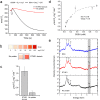BigR is a sulfide sensor that regulates a sulfur transferase/dioxygenase required for aerobic respiration of plant bacteria under sulfide stress
- PMID: 29472641
- PMCID: PMC5823870
- DOI: 10.1038/s41598-018-21974-x
BigR is a sulfide sensor that regulates a sulfur transferase/dioxygenase required for aerobic respiration of plant bacteria under sulfide stress
Abstract
To cope with toxic levels of H2S, the plant pathogens Xylella fastidiosa and Agrobacterium tumefaciens employ the bigR operon to oxidize H2S into sulfite. The bigR operon is regulated by the transcriptional repressor BigR and it encodes a bifunctional sulfur transferase (ST) and sulfur dioxygenase (SDO) enzyme, Blh, required for H2S oxidation and bacterial growth under hypoxia. However, how Blh operates to enhance bacterial survival under hypoxia and how BigR is deactivated to derepress operon transcription is unknown. Here, we show that the ST and SDO activities of Blh are in vitro coupled and necessary to oxidize sulfide into sulfite, and that Blh is critical to maintain the oxygen flux during A. tumefaciens respiration when oxygen becomes limited to cells. We also show that H2S and polysulfides inactivate BigR leading to operon transcription. Moreover, we show that sulfite, which is produced by Blh in the ST and SDO reactions, is toxic to Citrus sinensis and that X. fastidiosa-infected plants accumulate sulfite and higher transcript levels of sulfite detoxification enzymes, suggesting that they are under sulfite stress. These results indicate that BigR acts as a sulfide sensor in the H2S oxidation mechanism that allows pathogens to colonize plant tissues where oxygen is a limiting factor.
Conflict of interest statement
The authors declare no competing interests.
Figures






Similar articles
-
Plant pathogenic bacteria utilize biofilm growth-associated repressor (BigR), a novel winged-helix redox switch, to control hydrogen sulfide detoxification under hypoxia.J Biol Chem. 2011 Jul 22;286(29):26148-57. doi: 10.1074/jbc.M111.234039. Epub 2011 Jun 1. J Biol Chem. 2011. PMID: 21632538 Free PMC article.
-
BigR, a transcriptional repressor from plant-associated bacteria, regulates an operon implicated in biofilm growth.J Bacteriol. 2007 Sep;189(17):6185-94. doi: 10.1128/JB.00331-07. Epub 2007 Jun 22. J Bacteriol. 2007. PMID: 17586627 Free PMC article.
-
Crystallization and preliminary X-ray analysis of BigR, a transcription repressor from Xylella fastidiosa involved in biofilm formation.Acta Crystallogr Sect F Struct Biol Cryst Commun. 2007 Jul 1;63(Pt 7):596-8. doi: 10.1107/S1744309107028722. Epub 2007 Jun 15. Acta Crystallogr Sect F Struct Biol Cryst Commun. 2007. PMID: 17620720 Free PMC article.
-
Essential role of sulfide oxidation in brain health and neurological disorders.Pharmacol Ther. 2025 Feb;266:108787. doi: 10.1016/j.pharmthera.2024.108787. Epub 2024 Dec 22. Pharmacol Ther. 2025. PMID: 39719173 Review.
-
Hydrogen sulfide in plants: from dissipation of excess sulfur to signaling molecule.Nitric Oxide. 2014 Sep 15;41:72-8. doi: 10.1016/j.niox.2014.02.005. Epub 2014 Feb 26. Nitric Oxide. 2014. PMID: 24582856 Review.
Cited by
-
The Sulfide-Responsive SqrR/BigR Homologous Regulator YgaV of Escherichia coli Controls Expression of Anaerobic Respiratory Genes and Antibiotic Tolerance.Antioxidants (Basel). 2022 Nov 28;11(12):2359. doi: 10.3390/antiox11122359. Antioxidants (Basel). 2022. PMID: 36552568 Free PMC article.
-
Generation and Physiology of Hydrogen Sulfide and Reactive Sulfur Species in Bacteria.Antioxidants (Basel). 2022 Dec 17;11(12):2487. doi: 10.3390/antiox11122487. Antioxidants (Basel). 2022. PMID: 36552695 Free PMC article. Review.
-
Increased intracellular persulfide levels attenuate HlyU-mediated hemolysin transcriptional activation in Vibrio cholerae.bioRxiv [Preprint]. 2023 Mar 13:2023.03.13.532278. doi: 10.1101/2023.03.13.532278. bioRxiv. 2023. Update in: J Biol Chem. 2023 Sep;299(9):105147. doi: 10.1016/j.jbc.2023.105147. PMID: 36993174 Free PMC article. Updated. Preprint.
-
Roles of single gene in plant hypoxia and pathogen responses.Plant Signal Behav. 2021 Oct 3;16(10):1934295. doi: 10.1080/15592324.2021.1934295. Epub 2021 Jun 2. Plant Signal Behav. 2021. PMID: 34077334 Free PMC article. Review.
-
H2S and reactive sulfur signaling at the host-bacterial pathogen interface.J Biol Chem. 2020 Sep 18;295(38):13150-13168. doi: 10.1074/jbc.REV120.011304. Epub 2020 Jul 22. J Biol Chem. 2020. PMID: 32699012 Free PMC article. Review.
References
Publication types
MeSH terms
Substances
LinkOut - more resources
Full Text Sources
Other Literature Sources

